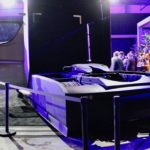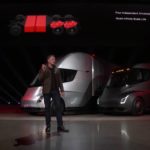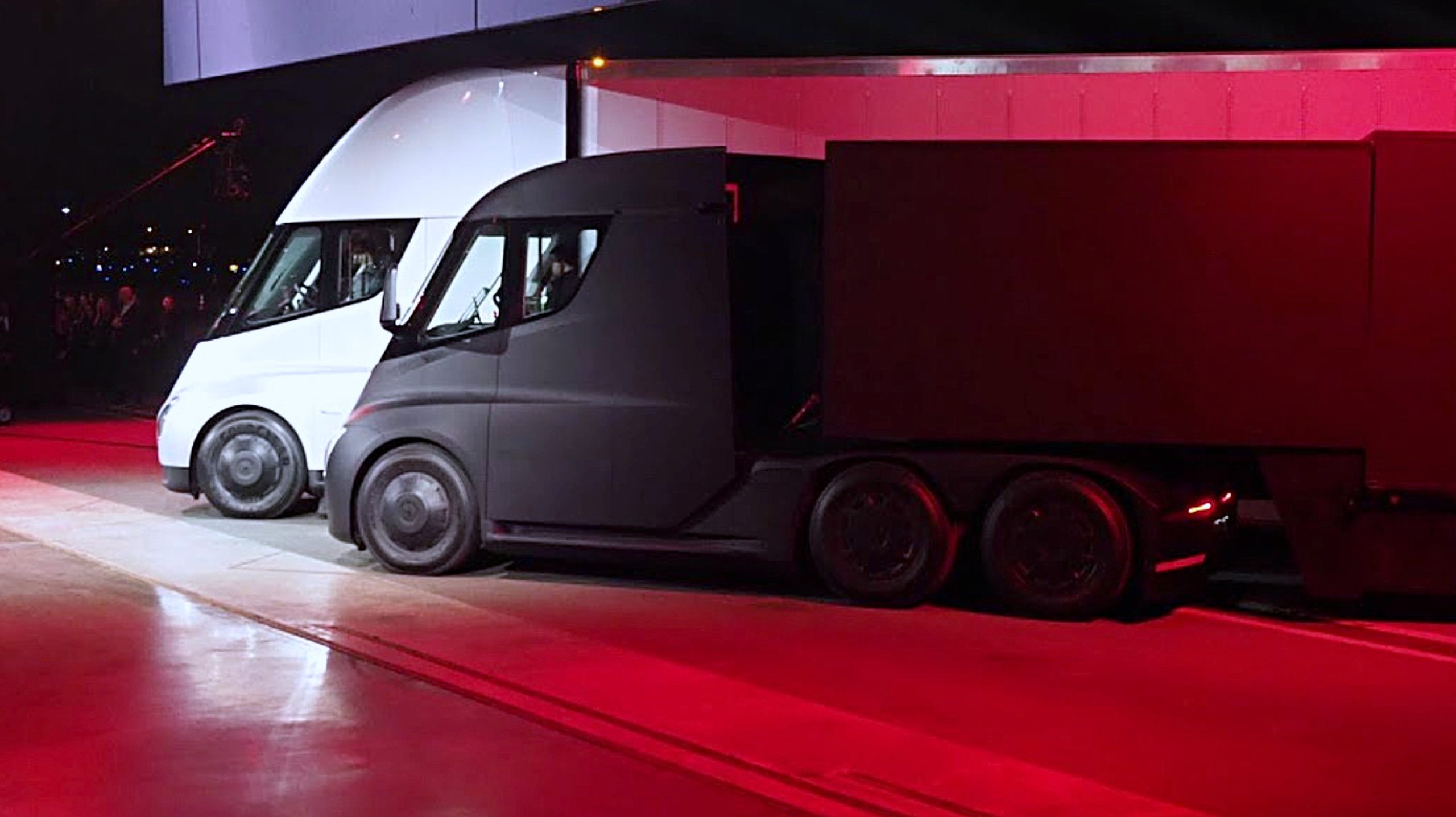
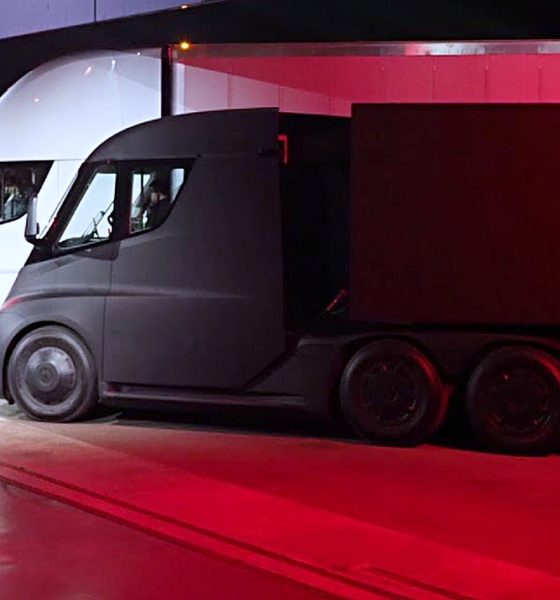
News
Tesla Semi truck’s battery pack and overall weight explored
The big question on everyone’s mind–at least on the minds of those who understand the freight transportation industry–is how much the Tesla Semi might weigh. If Tesla’s all-electric semi truck is to be competitive at all, it must be capable of carrying the same loads as current-use semi-trucks in the Class 8 field do.
A big point of contention from nay-sayers and those in the trucking industry who understand logistics was the lack of announcement of the Tesla Semi’s actual weight. Plenty of press was given to the much-touted “80,000-pound capacity” number bandied around by CEO Elon Musk during the truck’s unveiling late last year. That number, however, refers only to the gross vehicle weight (GVW) of the Tesla Semi and is, in fact, exactly the same number used by every Class 8 truck on the road. They’re called Class 8s, in fact, because the 8 refers to that 80,000-pound total vehicle capacity.
What wasn’t given by Tesla was the gross vehicle tare weight (GVTW) of the Semi. This is a far more important number. Where the GVW gives the total capacity of the truck in terms of how much its freight plus the truck itself can weigh, the GVTW gives just the weight of the truck, sans trailer and freight. This number tells logistics experts how much actual freight and trailer the truck can haul legally.
For example, a typical “day cab” configuration 18-wheeler with a diesel engine weighs roughly 32,000 pounds with a relatively lightweight box trailer attached and full fuel tanks. That leaves about 48,000 pounds of freight capacity for the truck. That’s important because, although the truck won’t be loaded to capacity every time, it will be expected to be capable of carrying up to about that weight. Most big rigs on the road are capable of hauling 44,000 or more pounds worth of freight, depending on configuration and trailer type.
Having experience with driving commercial trucks in the past, once hauling a refrigerated trailer that had a freight capacity of 44,500 pounds, I learned that some industries count on freight capacity as part of their logistics costs and will literally fill a truck to its maximum in order to minimize those costs.
In logistics, weight and total freight capacity are highly important metrics in the overall scheme.
What We Know
Thinking about that, then, let’s look at what we know of the Tesla Semi and its potential weight. We know that the truck uses four independent electric motors that are derived from the Model 3, that it has an energy consumption of less than 2 kWh per mile, and that it can be charged to up to 400 miles in about half an hour. We also know that Elon promised 300 to 500 miles of range in total. On that latter point, it’s pretty clear that a “lower range, cheaper option” will be offered as has been done with most of Tesla’s vehicles to-date. So we can assume a 300-mile version and a 500-mile version will be forthcoming for the Semi.
We also know that the Tesla Semi had eight ports in its charging plug array. We saw this at the unveil in some close-up photos.
It’s clear to us that even if the Tesla Semi isn’t to become a big player in the trucking industry, the idea behind it will change things forever.
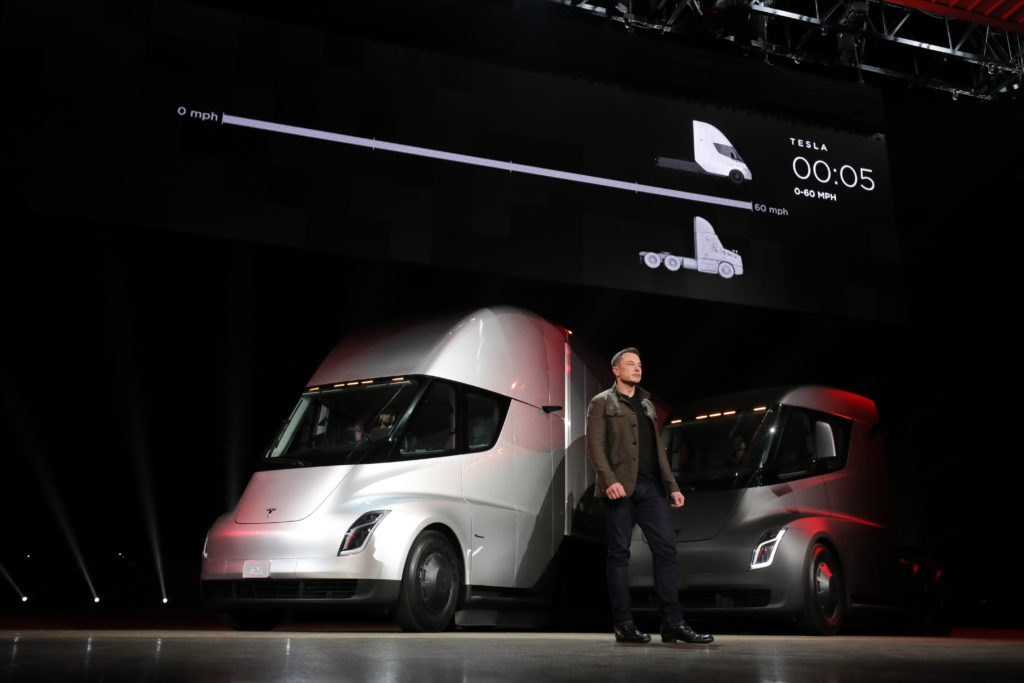
What We Don’t Know
What we don’t know is whether Musk and Co have something up their sleeves for the batteries. Much of the speculation regarding the Tesla Semi has been in regards to Tesla Semi’s massive battery pack.
In actuality, having a huge battery breakthrough on a vehicle like the Tesla Semi would not necessarily be a good thing for business. If there is a huge breakthrough, then all bets are off and most of our speculation in this article is moot. That would, however, mean that the sales potential of the Semi would be far lower than it would be otherwise because one thing that logistics companies and fleet managers aren’t interested in are flashy new, breakthrough, and (most importantly) untested, unproven technologies.
To a fleet manager, those phrases mean “breaks often, expensive to fix” and the potential positives will be ignored because of that. No one who wants to keep a job as a fleet manager or logistics purchaser will gamble on something unproven. Like new battery technology for a truck whose primary cost will be in its batteries. Likewise, unless there is a clear benefit in some terms other than pure business (like marketing or potential tax breaks), no board of directors will risk shareholder wrath on new tech either.
Close-up look at Tesla Semi’s drivetrain from underneath
We can say, as a side note, that most of the orders that have been placed for the Tesla Semi thus far are from corporations and companies who are doing business in areas where the marketing bonanza and potential tax incentives for laying down those relatively low-cost deposits are immense. Most of the companies involved have already invested heavily (and very publicly) in alternative fuel options outside of Tesla over the past few years. We also note the timing of both the Tesla Semi’s announcement (and order-taking) and the before-2018 rush by potential customers to put in deposits.
We reiterate that our not knowing if Tesla has some kind of big battery breakthrough announcement is a big “if” in our analysis here.
What People Smarter Than Us Have Said
Some people who know more than we do about things like math and engineering science have crunched the numbers on the Tesla Semi’s battery potentials. Over at Engineering.com, John Ewbank broke the results down into layman format. Here’s the gist.
If the Tesla Semi uses 2 kWh to travel a mile, then a 500-mile range means 1,000 kWh of power. That is not the actual size of the battery, though, as the charging requirement would preclude a huge pack.
In order to get 400 miles in thirty minutes of charging, Ewbank notes, the charger would have to be 1.6MW to achieve the 800kWh of promised charge in only 30 minutes. Charging at that rate is not possible because the result would be arching in the pack, which would surely be akin to the next Boring Company Flamethrower meme when Semi trucks begin to explode in flames during charging as a regular event. So the charging has to be split up.
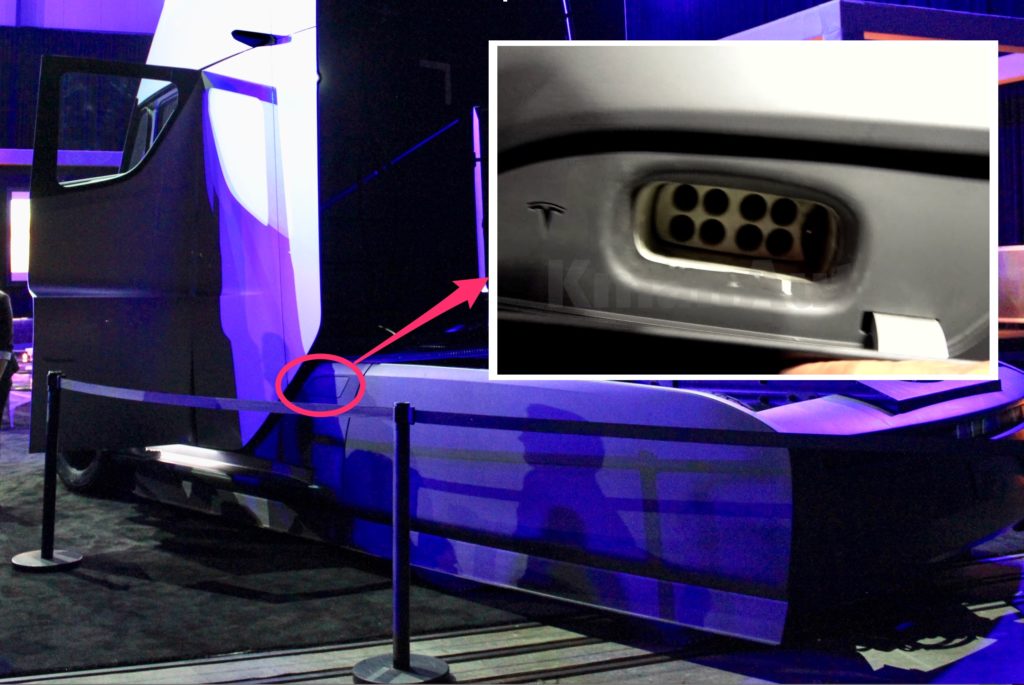
Tesla Semi Megacharger port could support 1 MW of power.
The answer is simple, of course, and may explain the strange layout of the eight-port charging hub shown on the Semi at its unveil: there are four battery packs.
Instead of one big pack, four smaller packs (one for each motor, even) are used and are thus charging separately from one another, but simultaneously. Based on Tesla Semi’s Megacharger port configuration, this would likely mean that four of them are positive sides and the other four are grounds. Allowing for a single, huge wire to be plugged into each. The controls for the charging system interface may be plugged in separately (perhaps the oval-shaped black thing to the side?).
What This Adds Up To
We add up that bit of information plus what we know about the truck and get an estimated weight. Using the current weight of a Tesla Model S battery pack at 540kg per 90 kWh, we can do some simple math to estimate the Semi’s batteries would weigh about 6,000 kg. We aren’t sure about the new battery weights for the upcoming battery updates, but we can assume a 10-15 percent reduction from several factors (storage density, improvements in chemistry, packaging lightening) without being too aggressive or overly optimistic. Going with the fifteen percent reduction, that 6,000 kg drops to 5,100 kg. That’s about 11,244 pounds.
A conventional tractor, as we’ve said, has a tare weight of around 32,000 pounds when fully fueled and with a lightweight box trailer in place. Remove the trailer and the truck itself is about 22,500 pounds. It’s difficult to then go to just the weight of the powertrain components and fuel, but they’re considerably less than 11,000 pounds in all.
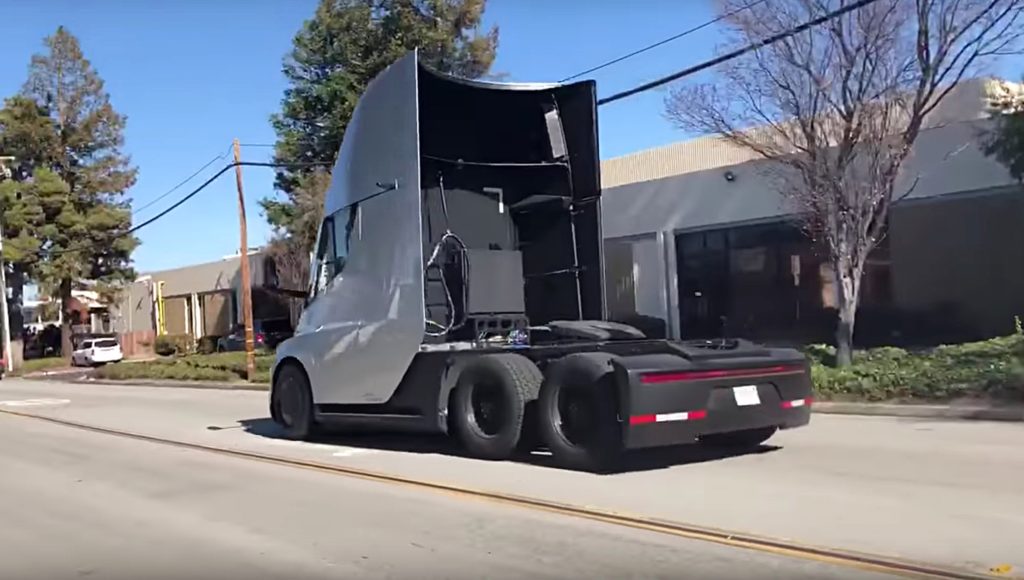
Tesla Semi spotted doing a tire-shredding acceleration run down in the wild
Looking at the shipping weight for a crated engine and transmission for a Class 8 truck, we can see that they weigh about 8,000 pounds on average. Add in fuel and other components and another 1,500 pounds (at most) are put on the truck. We then assume that the rest of the truck (framing, braking systems, air compressor, etc) are about the same for the Tesla Semi in order for it to meet Class 8 standards. So we call those a wash.
That means that the Semi, under our estimates, is roughly two tons heavier than would be a standard day cab big truck in the Class 8 category. This means the Semi would be that much less capable in terms of freight hauling that’s offset by its unprecedented all-electric performance. That amount, however, is probably not enough to stop the primary buyers of a day cab truck like this from balking at a purchase. The weight difference alone would be repaid in potential fuel savings, tax incentives, green marketing, and maintenance costs.
The trouble will come with cost differences. If the ROI is not there, most logistics buyers won’t write any purchase orders. But at least we can say that as far as we can tell, the weight differences of the Tesla Semi alone aren’t going to be a huge bar against entry into the trucking industry.

Cybertruck
Tesla updates Cybertruck owners about key Powershare feature

Tesla is updating Cybertruck owners on its timeline of a massive feature that has yet to ship: Powershare with Powerwall.
Powershare is a bidirectional charging feature exclusive to Cybertruck, which allows the vehicle’s battery to act as a portable power source for homes, appliances, tools, other EVs, and more. It was announced in late 2023 as part of Tesla’s push into vehicle-to-everything energy sharing, and acting as a giant portable charger is the main advantage, as it can provide backup power during outages.
Cybertruck’s Powershare system supports both vehicle-to-load (V2L) and vehicle-to-home (V2H), making it flexible and well-rounded for a variety of applications.
However, even though the feature was promised with Cybertruck, it has yet to be shipped to vehicles. Tesla communicated with owners through email recently regarding Powershare with Powerwall, which essentially has the pickup act as an extended battery.
Powerwall discharge would be prioritized before tapping into the truck’s larger pack.
However, Tesla is still working on getting the feature out to owners, an email said:
“We’re writing to let you know that the Powershare with Powerwall feature is still in development and is now scheduled for release in mid-2026.
This new release date gives us additional time to design and test this feature, ensuring its ability to communicate and optimize energy sharing between your vehicle and many configurations and generations of Powerwall. We are also using this time to develop additional Powershare features that will help us continue to accelerate the world’s transition to sustainable energy.”
Owners have expressed some real disappointment in Tesla’s continuous delays in releasing the feature, as it was expected to be released by late 2024, but now has been pushed back several times to mid-2026, according to the email.
Foundation Series Cybertruck buyers paid extra, expecting the feature to be rolled out with their vehicle upon pickup.
Cybertruck’s Lead Engineer, Wes Morrill, even commented on the holdup:
As a Cybertruck owner who also has Powerwall, I empathize with the disappointed comments.
To their credit, the team has delivered powershare functionality to Cybertruck customers who otherwise have no backup with development of the powershare gateway. As well as those with solar…
— Wes (@wmorrill3) December 12, 2025
He said that “it turned out to be much harder than anticipated to make powershare work seamlessly with existing Powerwalls through existing wall connectors. Two grid-forming devices need to negotiate who will form and who will follow, depending on the state of charge of each, and they need to do this without a network and through multiple generations of hardware, and test and validate this process through rigorous certifications to ensure grid safety.”
It’s nice to see the transparency, but it is justified for some Cybertruck owners to feel like they’ve been bait-and-switched.
News
Tesla’s northernmost Supercharger in North America opens

Tesla has opened its northernmost Supercharger in Fairbanks, Alaska, with eight V4 stalls located in one of the most frigid cities in the U.S.
Located just 196 miles from the Arctic Circle, Fairbanks’s average temperature for the week was around -12 degrees Fahrenheit. However, there are plenty of Tesla owners in Alaska who have been waiting for more charging options out in public.
There are only 36 total Supercharger stalls in Alaska, despite being the largest state in the U.S.
Eight Superchargers were added to Fairbanks, which will eventually be a 48-stall station. Tesla announced its activation today:
North America’s northernmost Supercharger Fairbanks, AK (8 stalls) opened to public. https://t.co/M4l04DZ6B5 pic.twitter.com/zyL6bDuA93
— Tesla Charging (@TeslaCharging) December 12, 2025
The base price per kWh is $0.43 at the Fairbanks Supercharger. Thanks to its V4 capabilities, it can charge at speeds up to 325 kW.
Despite being the northernmost Supercharger in North America, it is not even in the Top 5 northernmost Superchargers globally, because Alaska is south of Norway. The northernmost Supercharger is in Honningsvåg, Norway. All of the Top 5 are in the Scandanavian country.
Tesla’s Supercharger expansion in 2025 has been impressive, and although it experienced some early-quarter slowdowns due to V3-to-V4 hardware transitions, it has been the company’s strongest year for deployments.
🚨🚨 Tesla Supercharging had a HUGE year, and they deserve to be recognized.
🍔 Opened Tesla Diner, a drive-in movie theater with awesome, Chef-curated cuisine
🔌 Gave access to Superchargers to several EV makers, including Hyundai, Genesis, Mercedes-Benz, Kia, Lucid, Toyota,… pic.twitter.com/yYT2QEbqoW
— TESLARATI (@Teslarati) December 10, 2025
Through the three quarters of 2025, the company has added 7,753 stations and 73,817 stalls across the world, a 16 percent increase in stations and an 18 percent increase in stalls compared to last year.
Tesla is on track to add over 12,000 stalls for the full year, achieving an average of one new stall every hour, an impressive statistic.
Recently, the company wrapped up construction at its Supercharger Oasis in Lost Hills, California, a 168-stall Supercharger that Tesla Solar Panels completely power. It is the largest Supercharger in the world.
News
Tesla shocks with latest Robotaxi testing move
Why Tesla has chosen to use a couple of Model S units must have a reason; the company is calculated in its engineering and data collection efforts, so this is definitely more than “we just felt like giving our drivers a change of scenery.”

Tesla Model S vehicles were spotted performing validation testing with LiDAR rigs in California today, a pretty big switch-up compared to what we are used to seeing on the roads.
Tesla utilizes the Model Y crossover for its Robotaxi fleet. It is adequately sized, the most popular vehicle in its lineup, and is suitable for a wide variety of applications. It provides enough luxury for a single rider, but enough room for several passengers, if needed.
However, the testing has seemingly expanded to one of Tesla’s premium flagship offerings, as the Model S was spotted with the validation equipment that is seen entirely with Model Y vehicles. We have written several articles on Robotaxi testing mules being spotted across the United States, but this is a first:
🚨 Tesla is using Model S vehicles fitted with LiDAR rigs to validate FSD and Robotaxi, differing from the Model Ys that it uses typically
Those Model Y vehicles have been on the East Coast for some time. These Model S cars were spotted in California https://t.co/CN9Bw5Wma8 pic.twitter.com/UE55hx5mdd
— TESLARATI (@Teslarati) December 11, 2025
Why Tesla has chosen to use a couple of Model S units must have a reason; the company is calculated in its engineering and data collection efforts, so this is definitely more than “we just felt like giving our drivers a change of scenery.”
It seems to hint that Tesla could add a premium, more luxury offering to its Robotaxi platform eventually. Think about it: Uber has Uber Black, Lyft has Lyft Black. These vehicles and services are associated with a more premium cost as they combine luxury models with more catered transportation options.
Tesla could be testing the waters here, and it could be thinking of adding the Model S to its fleet of ride-hailing vehicles.
Reluctant to remove the Model S from its production plans completely despite its low volume contributions to the overall mission of transitioning the world to sustainable energy, the flagship sedan has always meant something. CEO Elon Musk referred to it, along with its sibling Model X, as continuing on production lines due to “sentimental reasons.”
However, its purpose might have been expanded to justify keeping it around, and why not? It is a cozy, premium offering, and it would be great for those who want a little more luxury and are willing to pay a few extra dollars.
Of course, none of this is even close to confirmed. However, it is reasonable to speculate that the Model S could be a potential addition to the Robotaxi fleet. It’s capable of all the same things the Model Y is, but with more luxuriousness, and it could be the perfect addition to the futuristic fleet.
